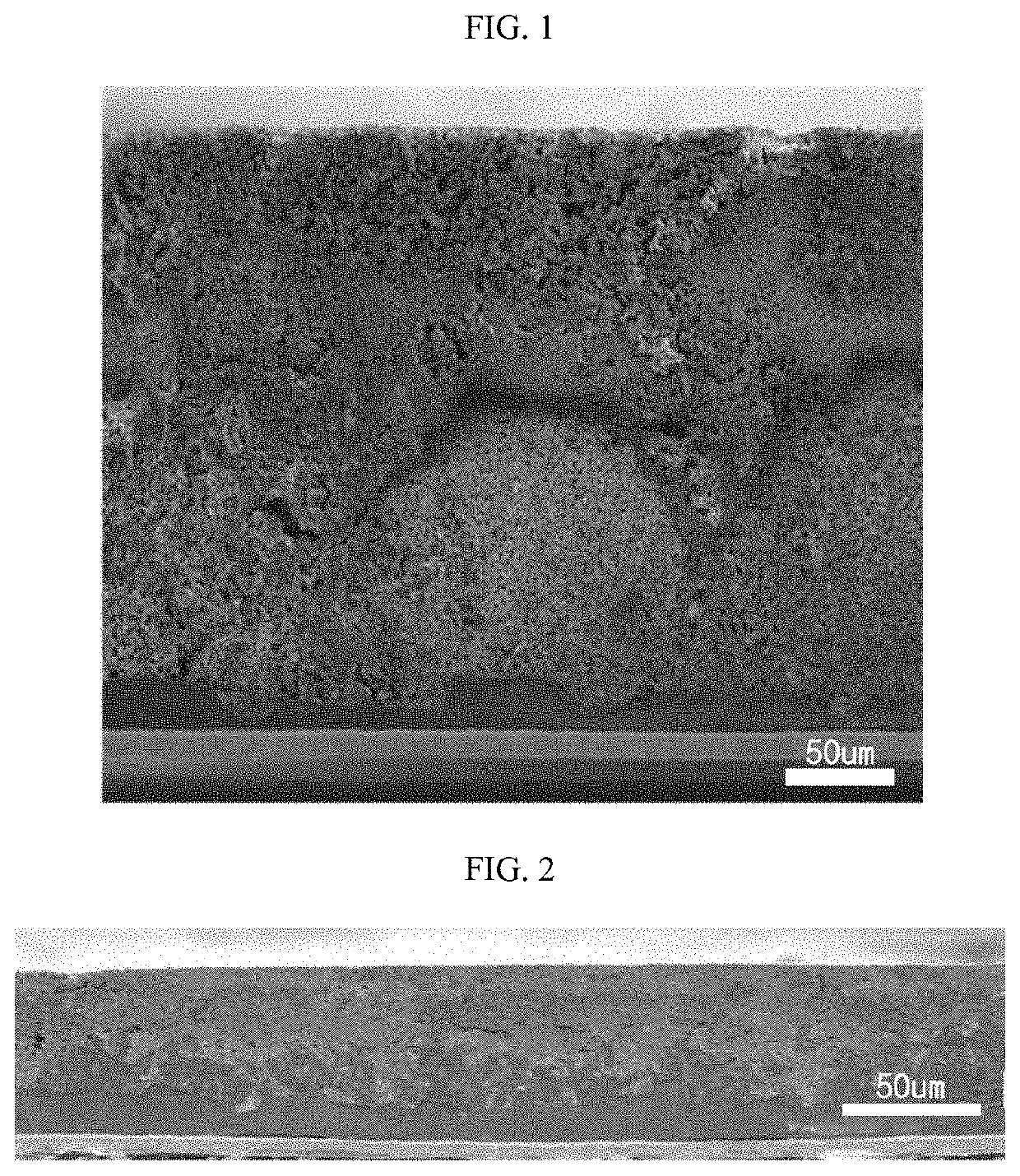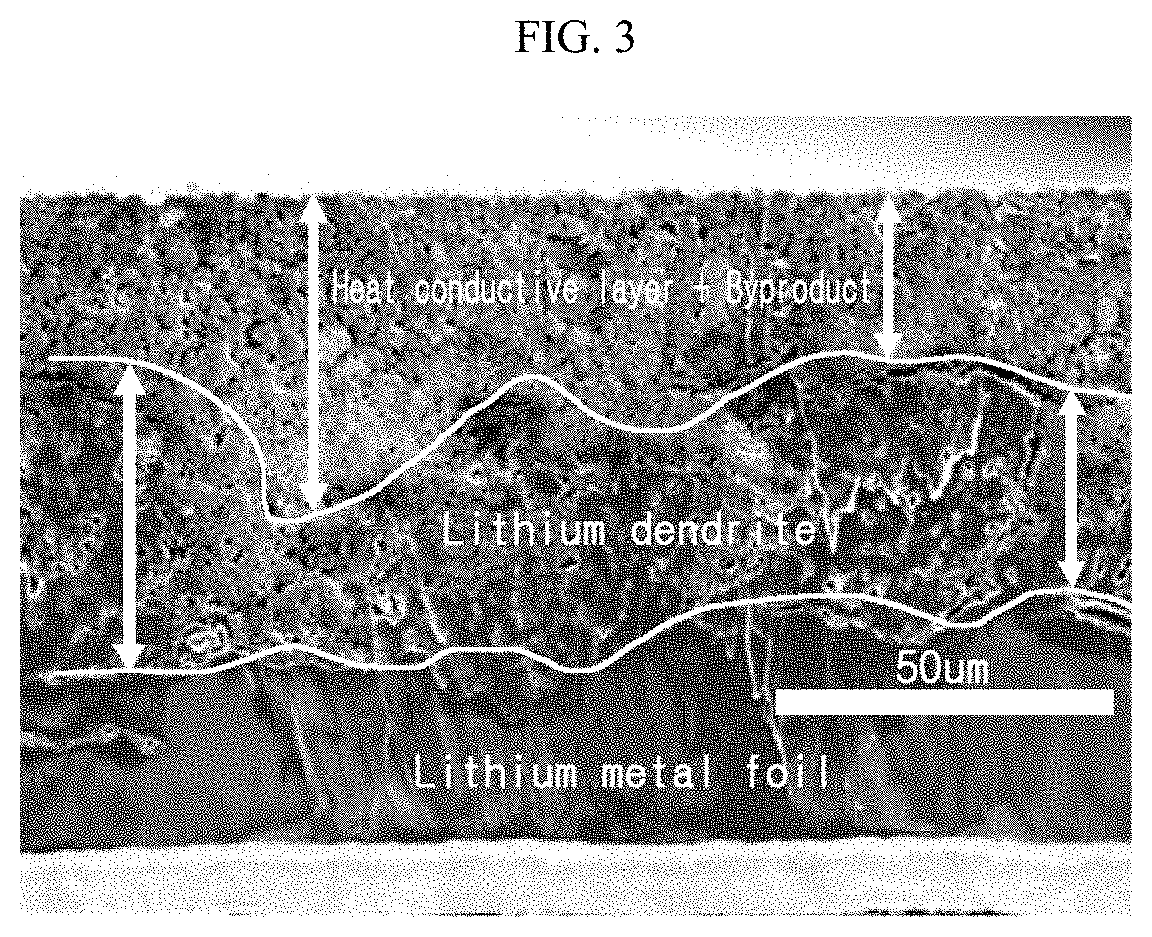Anode for lithium metal battery, and electrochemical device comprising same
a lithium metal battery and anode technology, applied in the manufacture of electrodes, cell components, electrochemical generators, etc., can solve the problems of degradation of the cycle characteristics, and achieve the effects of improving the problem, increasing the thickness of the electrode assembly, and reducing the number of electrodes
- Summary
- Abstract
- Description
- Claims
- Application Information
AI Technical Summary
Benefits of technology
Problems solved by technology
Method used
Image
Examples
example 2
[0115]A lithium metal battery was obtained in the same manner as described in Example 1, except that the negative electrode was obtained by the method described hereinafter.
[0116]First, in the same manner as Example 1, a structure including a current collector; a negative electrode active material layer disposed on the current collector; and a heat conductive layer disposed on the negative electrode active material layer was manufactured.
[0117]Next, slurry for forming a ceramic layer was applied onto the surface of the heat conductive layer by using a doctor blade, and dried at 60° C. for 3 hours to form a ceramic layer. The slurry for forming a ceramic layer was prepared as follows. At room temperature, Al2O3 inorganic particles (Japan Light Metal Co., LS235, particle size 500 nm, Vicker's hardness: 17.5 GPa) and a binder (PVDF-HFP) were introduced to acetone at a weight ratio of 9:1, followed by agitation, to prepare slurry for forming a ceramic layer. The ceramic layer had a thic...
example 3
[0118]A lithium metal battery was obtained in the same manner as described in Example 1, except that the negative electrode was obtained by the method described hereinafter.
[0119]First, in the same manner as Example 1, a structure including a current collector; a negative electrode active material layer disposed on the current collector; and a heat conductive layer disposed on the negative electrode active material layer was manufactured.
[0120]Next, slurry for forming a porous polymer layer was applied onto the surface of the heat conductive layer by using a doctor blade and dried at a temperature of 60° C. for 3 hours to form a porous polymer layer. The slurry for forming a porous polymer layer was prepared as follows. First, 10 g of polyethylene oxide as a polymer was added to 100 g of acetone as a solvent to prepare a polymer solution. Next, 20 g of water as a non-solvent was added to the polymer solution to form slurry for forming a porous polymer layer. While the polymer soluti...
example 4
[0122]A lithium metal battery was obtained in the same manner as described in Example 1, except that the negative electrode was obtained by the method described hereinafter.
[0123]First, in the same manner as Example 1, a structure including a current collector; a negative electrode active material layer disposed on the current collector; and a heat conductive layer disposed on the negative electrode active material layer was manufactured.
[0124]Next, slurry for forming a ceramic layer was applied onto the surface of the heat conductive layer by using a doctor blade, and dried at 60° C. for 3 hours to form a ceramic layer. The slurry for forming a ceramic layer was prepared as follows. At room temperature, Al2O3 inorganic particles (Japan Light Metal Co., LS235, particle size 500 nm, Vicker's hardness: 17.5 GPa) and a binder (PVDF-HFP) were introduced to acetone at a weight ratio of 9:1, followed by agitation, to prepare slurry for forming a ceramic layer. The ceramic layer had a thic...
PUM
 Login to View More
Login to View More Abstract
Description
Claims
Application Information
 Login to View More
Login to View More - R&D
- Intellectual Property
- Life Sciences
- Materials
- Tech Scout
- Unparalleled Data Quality
- Higher Quality Content
- 60% Fewer Hallucinations
Browse by: Latest US Patents, China's latest patents, Technical Efficacy Thesaurus, Application Domain, Technology Topic, Popular Technical Reports.
© 2025 PatSnap. All rights reserved.Legal|Privacy policy|Modern Slavery Act Transparency Statement|Sitemap|About US| Contact US: help@patsnap.com


